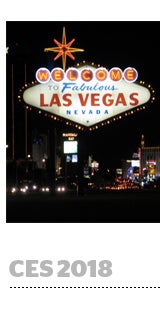The center of media activity at CES is the C Space in the Aria hotel. Here you will find the private meeting spaces booked by Turner, Spotify, Twitter, Oath, CBS, NBCU and Samsung Ads.
As in the past, the C Space showroom floor – ostensibly an ad tech vendor showcase – was pretty barren this year, except for the occasional moment when celebrities like Neil Patrick Harris showed up at a booth to promote a tech partnership. It’s still unclear what the showroom is actually for, as this year it had a strange hodgepodge of vendors, not all of whom had an offering related to marketing or ad tech.
The big question, as always, was what’s hot. While no single trend out of CES is likely to immediately affect the marketing and advertising industry, a couple of items stuck out – namely, voice interfaces and advanced modes of TV buying.
Sound On
Amazon and Google made a show of force with their automated assistants, Alexa and Google Assistant, respectively. Clearly there’s a battle to dominate the IoT home.
The rise of voice controls and queries will inevitably create marketing opportunities – requiring serious thought around user interface, acceptability and privacy. Those questions will keep advertisers from buying in immediately, save for the occasional one-off experiment.
“My questions would probably be consistent with what I ask everyone else: What’s the format, how does it lend certain types of experience and what kind of data can I get out of it to understand those experiences and modify effectiveness?” said Essence Global CEO Christian Juhl. “It’s always about the right data. More data is not the answer; it’s the right data relative to the brand and consumer.”
Nielsen-owned Gracenote, which provides automated content recognition (among other things), has been retagging its existing data sets to accommodate how people search via voice. So if someone wants “Daniel Craig James Bond movies,” the system will be able to parse that phrase and return relevant results.
Gracenote’s effort is nascent – and the work is centered around getting the interface right. So the idea of introducing ads that could potentially interrupt that voice user interface is still a long way off.
“We’re still in the very early innings of this,” said Spotify’s head of ads monetization, Brian Benedik. “I was just at the convention center yesterday. There’s a lot of talk here at CES around voice. I’ve been coming to CES for a long time. Anything that’s talked about takes a few years to develop.”
Another issue is user acceptance. Will consumers be comfortable with a system that records and analyzes their voices, and uses the raw data to target ads?
“With IoT, the dialogue around protecting and privacy gets louder. How is that being factored into the conversation?” said Sargi Mann, digital EVP at Havas Media.
Addressable TV: Live
Addressable ads on television are much further along. A flurry of partnerships and product releases indicate vendors including Google, Mediaocean and BrightLine have been gearing up for the acceleration of addressable TV with partnerships and product launches.
Last April, Google let buyers purchase addressable TV through DoubleClick Bid Manager. More recently – this month – Mediaocean, which automates parts of the TV-buying process, signed a deal with Adobe Marketing Cloud.
But the trend in 2018 is pointing toward the advent of addressability in live or linear video.
“One of the biggest things we’ll tackle this year is around live CTV and OTT,” said Mike Shehan, founder and CEO of SpotX, adding that the vendor works with Dish’s Sling TV, 90% of which is live. “You’ve got a lot of challenges filling a pod of ads on a live broadcast for OTT.” Chief among them is dealing with 100,000 to 200,000 simultaneous calls into the system.
Video ad server Innovid also works with Sling TV. The vendor’s CTO, Tal Chalozin, said Innovid has enabled data driven and dynamic creative decisioning on the OTT service since it went live on 2015. But he too anticipates a 2018 uptick in live video monetization, as the different technological parts needed to insert ads into live streams are finally aligning.
The technology is also coming together to enable ad insertion into linear TV, said Eric Mathewson, CEO of WideOrbit.
“Our plumbing is finally in place,” he said. “Someone literally can call WideOrbit and move $600 million onto the platform today. And we would be able to execute it in a week.”
But when it comes to targeted TV ads specifically, not everyone is entirely on board. After all, how fast are ad dollars are migrating to addressable TV buys?
“I always look at it in terms of ad spend,” said Megan Clarken, president of Nielsen’s Watch division. EMarketer noted a spike in addressable TV spend in 2018 – 78.7% growth from 2017, to $2.25 billion. By 2019, that growth rate will taper off to 35.3%, to $3.04 billion. And that’s still only 4% of total TV ad spend.
“There are so many things that need to line up,” Clarken said.
For instance, will a targeted TV ad provide a similar or better outcome than a digital pure-play with great reach? Is it better to hit a lot of people at once with one creative, rather than to use the TV screen to target? How much does it cost to place a targeted TV ad? Is the infrastructure ready? And will an advertiser be willing to make the jump?
And Tim Mahlman, president of ad platforms at Oath, doesn’t anticipate a watershed in addressable TV buying this year.
“I don’t see anything changing in 2018,” he said. “But if you look into further years, we’ve been having discussions at CES specially about it.”













